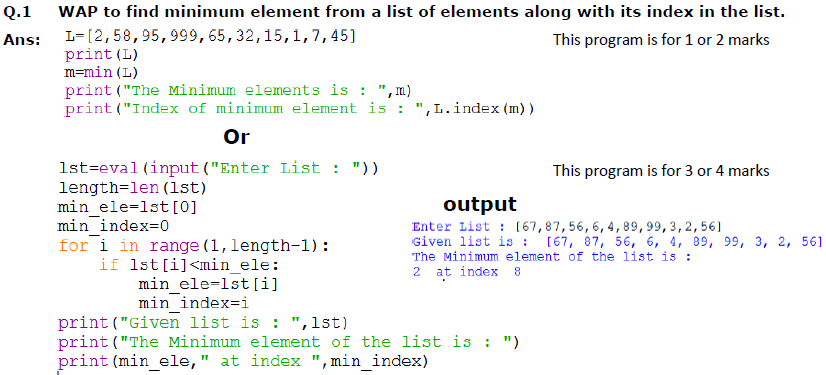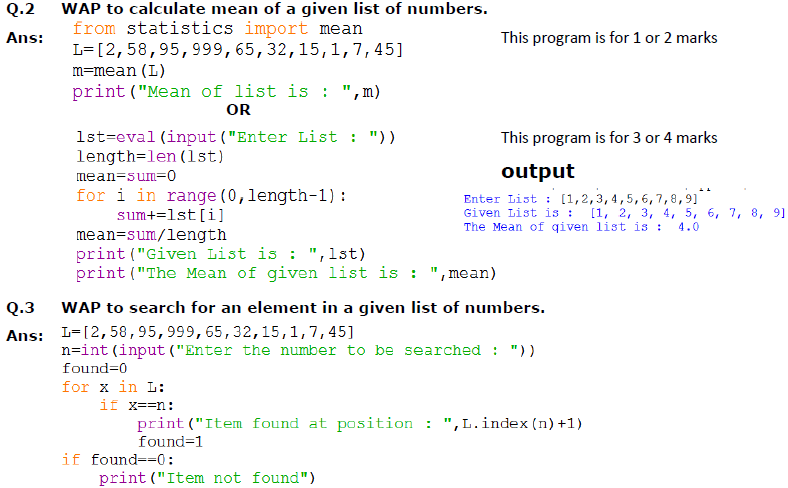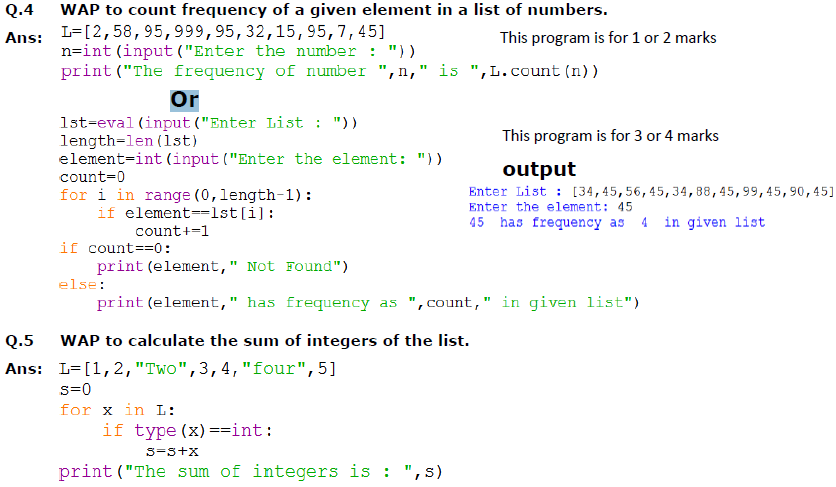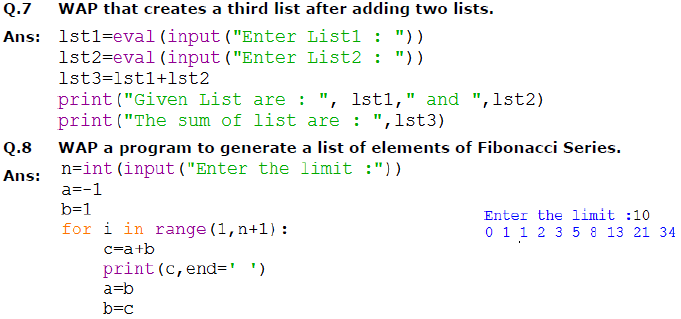Read and download free pdf of CBSE Class 11 Information Practices List Manipulation Worksheet. Students and teachers of Class 11 Informatics Practices can get free printable Worksheets for Class 11 Informatics Practices List Manipulation in PDF format prepared as per the latest syllabus and examination pattern in your schools. Class 11 students should practice questions and answers given here for Informatics Practices in Class 11 which will help them to improve your knowledge of all important chapters and its topics. Students should also download free pdf of Class 11 Informatics Practices Worksheets prepared by teachers as per the latest Informatics Practices books and syllabus issued this academic year and solve important problems with solutions on daily basis to get more score in school exams and tests
Worksheet for Class 11 Informatics Practices List Manipulation
Class 11 Informatics Practices students should download to the following List Manipulation Class 11 worksheet in PDF. This test paper with questions and answers for Class 11 will be very useful for exams and help you to score good marks
Class 11 Informatics Practices Worksheet for List Manipulation
Very Short answer Type Questions
Question: What do you understand by mutability?
Answer: Mutable means changeable. In Python, mutable types are those whose values can be changed in place. Only three types are mutable in python – Lists, Dictionaries and Sets.
Question: Start with the list[8,9,10]. Do the following using list functions
(a) Set the second entry (index 1) to 17
(b) Add 4, 5 and 6 to the end of the list.
(c) Remove the first entry from the list.
(d) Sort the list.
(e) Double the list.
(f) Insert 25 at index 3
Answer: (a) list[1]=17
(b) list.append(4)
list.append(5)
list.append(6)
(c) list.pop(0)
(d) list.sort()
(e) list=list*2
(f) list.insert(3,25)
Question: If a is [1, 2, 3], what is the difference (if any) between a*3 and [a, a, a]?
Answer: a*3 will produce [1,2,3,1,2,3,1,2,3], means a list of integers and [a, a, a] will produce [[1,2,3],[1,2,3],[1,2,3]], means list of lists
Question: If a is [1, 2, 3], is a * 3 equivalent to a + a + a?
Answer:Yes, Both a*3 and a+a+a will produce same result.

Question: If a is [1, 2, 3], what is the meaning of a [1:1] = 9?
Answer: This will generate an error “TypeError: can only assign an iterable”.
Question:If a is [1, 2, 3], what is the meaning of a [1:2] = 4 and a [1:1] = 4?
Answer: These will generate an error “TypeError: can only assign an iterable”.
Question:What are list slices?
Answer: List slices are the sub-part of a list extracted out. You can use indexes of the list elements to create list slices as per following format. Syntax is as follows –
Seq=ListName[start:stop]
Question: Does a slice operator always produce a new list?
Answer: Yes, this will create a new list.
Short Answer Type Questions
Question: How are lists different from strings when both are sequences?
Answer: Lists are similar to strings in many ways like indexing, slicing, and accessing individual elements but they are different in the sense that
(i) Lists are mutable while strings are immutable.
(ii) In consecutive locations, strings store the individual characters while list stores the references of its elements.
(iii) Strings store single type of elements-all characters while lists can store elements belonging to different types.
Question: What are nested Lists?
Answer: A list can have an element in it, which itself is a list. Such a list is called nested list. e.g.
L = [1,2,3,4,[5,6,7],8]
Question: Discuss the utility and significance of Lists.
Answer:The list is a most versatile datatype available in Python which can be written as a list of comma-separated values (items) between square brackets. Important thing about a list is that items in a list need not be of the same type. List is majorly used with dictionaries when there is large number of data.
Question: What is the purpose of the del operator and pop method? Try deleting a slice.
Answer: del operator is used to remove an individual item, or to remove all items identified by a slice. It is to be used as per syntax given below –
del List[index]
del List[start:stop]
pop method is used to remove single element, not list slices. The pop() method removes an individual item and returns it. Its syntax is –
a=List.pop() #this will remove last item and deleted item will be assigned to a.
a=List[10] # this will remove the ite at index 10 and deleted item will be assigned to a.
Question: What are list slices?
Answer: List slices, like string slices are the sub part of a list extracted out. Indexes can be used to create list slices as per following format:
seq = L[start:stop]
Question: What do you understand by true copy of a list? How is it different from shallow copy?
Answer: A shallow copy means constructing a new collection object and then populating it with references to the child objects found in the original. In essence, a shallow copy is only one level deep. The copying process does not recurse and therefore won‟t create copies of the child objects themselves.
True Copy means you can create a copy of a list using New_list=My_list. The assignment just copies the reference to the list, not the actual list, so both new_list and my_list refer to the same list after the assignment.

Skill Based Questions




Worksheet for CBSE Informatics Practices Class 11 List Manipulation
We hope students liked the above worksheet for List Manipulation designed as per the latest syllabus for Class 11 Informatics Practices released by CBSE. Students of Class 11 should download in Pdf format and practice the questions and solutions given in the above worksheet for Class 11 Informatics Practices on a daily basis. All the latest worksheets with answers have been developed for Informatics Practices by referring to the most important and regularly asked topics that the students should learn and practice to get better scores in their class tests and examinations. Expert teachers of studiestoday have referred to the NCERT book for Class 11 Informatics Practices to develop the Informatics Practices Class 11 worksheet. After solving the questions given in the worksheet which have been developed as per the latest course books also refer to the NCERT solutions for Class 11 Informatics Practices designed by our teachers. We have also provided a lot of MCQ questions for Class 11 Informatics Practices in the worksheet so that you can solve questions relating to all topics given in each chapter.
You can download the CBSE Printable worksheets for Class 11 Informatics Practices List Manipulation for latest session from StudiesToday.com
There is no charge for the Printable worksheets for Class 11 CBSE Informatics Practices List Manipulation you can download everything free
Yes, studiestoday.com provides all latest NCERT List Manipulation Class 11 Informatics Practices test sheets with answers based on the latest books for the current academic session
CBSE Class 11 Informatics Practices List Manipulation worksheets cover all topics as per the latest syllabus for current academic year.
Regular practice with Class 11 Informatics Practices worksheets can help you understand all concepts better, you can identify weak areas, and improve your speed and accuracy.

